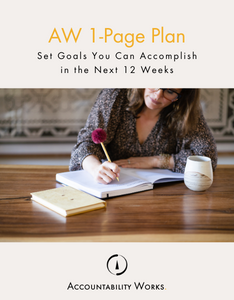I’m really enjoying working through BJ Fogg’s Tiny Habits methodology with our coaching team. For us, it’s been a return to the basics of behavior change. The first time I read the book, I learned a lot, but I didn’t engage with the material as thoroughly as I am this quarter. Some tiny habits have been easy to adopt, while others have been more challenging. My hope is to give you a little insight into what we are doing as coaches and inspire you to see where you can make tiny tweaks in your own habits and routines.
The Methodology
The Tiny Habits methodology is quite simple: the behavior you want to adopt or the change you want to make is equal to your motivation (M) to do it, your ability (A) to do it, and a prompt (P) that reminds you to do it. In Fogg’s shorthand, this is expressed as:
B=MAP
The Most Important Variables
In this equation, the least reliable variable is motivation because it fluctuates. Motivation can be high or low at any given time, so it’s crucial to focus on the other two variables: ability and prompt.
Ability is where the “tiny” comes in. Yes, you may want to meditate for 20 minutes daily, run 5 miles, or achieve another big goal. However, difficult tasks require high motivation, so you need to think about the smallest increment toward that goal that you can manage, regardless of your motivation level. For example, meditate for at least 1 minute daily or put on your running shoes every morning. These tiny actions are doable regardless of your motivation level.
Prompts are essential because they remind us to take action.
There are three kinds of prompts:
- Person prompts: Bodily reminders, like feeling hungry or needing to use the restroom.
- Context prompts: External reminders, like phone notifications or sticky notes.
- Action prompts: Building on behaviors you already do. These prompts are so effective that Fogg calls them anchors.
Anchor Moments
I added two tiny habits to my weekly commitments: meditating at least 1 minute daily and journaling at least 1 word daily. Although these are activities I enjoy, I don’t do them daily or as part of a routine. My mornings vary depending on the day, workout times, kids’ school schedules, and carpool duties. As someone who thrives on routine, I wanted to incorporate these activities but found it challenging.
My first realization was that I had to decouple them. These habits had previously been linked. I decided on the anchor of brushing my teeth for meditation. On workout days, I can only manage a tiny meditation; on non-workout days, I meditate longer. For journaling, I anchored it to breakfast. I never miss breakfast, even if the timing varies. Instead of reading news or emails, I now write in my journal, replacing a mindless habit with a more mindful one. I am starting to understand the power of the right prompt.
The Maui Habit
One last idea is the Maui Habit, our first assignment as coaches. It’s a good way to practice the ABCs of tiny habits. The Maui Habit involves waking up and, as your feet hit the ground, saying, “Today is going to be a great day.” If the day looks challenging, modify it to, “Today is going to be a great day in some way.”
- Anchor Moment: An existing routine, like getting out of bed.
- New Tiny Behavior: Saying, “Today is going to be a great day.”
- Instant Celebration: Give yourself a small dopamine hit to reinforce the behavior. I’ve found that smiling to myself does the trick.
Finding the right prompt was our biggest challenge, but it was well worth it. You can check out BJ Fogg’s TED Talk for more on the Maui Habit. As AW Coach Kelly Day O’Brien shared after practicing it for a few weeks:
“Well-being is realized by small steps, but it’s no small thing.” — Zeno
What’s Your Tiny Habit?
By focusing on tiny, achievable actions and finding the right prompts, you can incorporate new habits into your daily routine. Start small (or, in this case, tiny), be consistent, and celebrate your successes. These small steps can lead to significant changes over time. For me, it’s meant six weeks of taking all my vitamins and supplements daily, which may seem small but is something I’ve always wanted to do. I’ll get back to you on daily meditation and writing, but it’s working well so far. What will it mean for you?



